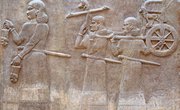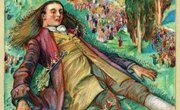Architecture is a key clue in understanding the symbolism and cultural values of the ancient Indian people. Intricate buildings such as temples, houses of worship and government buildings were adorned with art. While a great deal of secular art was produced in India from the Vedic ages in roughly 1500 B.C. through to early modern times, much of it was made of organic and perishable materials. In the equatorial and monsoon-prone climate of India, it has not survived. Religious art, however, was typically made of stone. These religious works of art and the architectural structures in which they were placed are of particular interest to historians.
Religious Iconography
In Hindu and Buddhist art and architecture, the gestures and postures of sculptural reliefs or friezes indicate various human functions, each ascribing its own meaning. The hand positions of the Buddha, for instance, symbolize enlightenment, meditation and teaching. Similarly, Hindu sculptures found in Indian architecture often depict deities such as Vishnu and Krishna with their hands in powerful positions, often appearing to have the ability to perform more than one task at the same time. This indicated the society's view of the deities as superior being. When placed in official or religious buildings, the religious icons served to symbolize the consecration of a building for the glory or praise of a particular god, teacher or religious viewpoint.
Hindu Temples
From the sixth century onwards, the resurgence of the Hindu dynasty led to the proliferation of Hindu temples throughout India. These temples were often built in a characteristic style with an entrance portico that would lead directly to a pillared hall or "mandapa." Every temple had a shrine as well as a large tower called a "shikhara." Of particular interest is the South Indian temple made in a Dravida style, which has a series of towers arranged as a terrace. Each tower represents a different divine force such as Vishnu or Krishna. The towers served as a constant reminder of the presence of religion in daily life as well as the power of the gods and religious teachers to effect everyday customs (see Reference 2).
Sculptures and Architecture
In the seventh century, the Pallava dynasty began to introduce a number of pyramid-like temples in Southern Indian. The Pallavas were known for their conquests and increasing control of further reaches of India. Many of their temples, for example, were found in the region of Mahabalipuram. These temples had giant carvings on their outer walls to represent important Pallava rulers, gods and even large animals such as elephants. The choice of which figures to depict on the temples had to do with the important cultural elements of the day, including imperial conquest, transport of goods and the economic dominance of the ruling class. Following the Pallavas, the 11th century Chola dynasty, known for their patronage of literature and their zeal in building temples, further developed this form of architecture. They chose to cast figures in bronze to represent eroticism and human love. Scenes of people dancing and enjoying one another's company were often present (see Reference 3).
Temple Townships
By the 17th century, British economic and political interest in India heightened with the establishment of the East India Company. The ruling Mughal Dynasty attempted to keep colonial interests at bay but by 1707, the dynasty collapsed into dozens of small states. Complex "temple townships" were developed as a result. Srirangam, an island in South India, was one of the largest of these and consisted of seven circles of temples, government buildings and homes. Often the buildings would be constructed in stucco, which was relatively cheap to manufacture and easy to assemble. The buildings would be adorned with figures of the devas, deities that represent the forces of nature and morality.
Related Articles
References
Resources
Writer Bio
Jeremy Bradley works in the fields of educational consultancy and business administration. He holds a Master of Business Administration degree.











